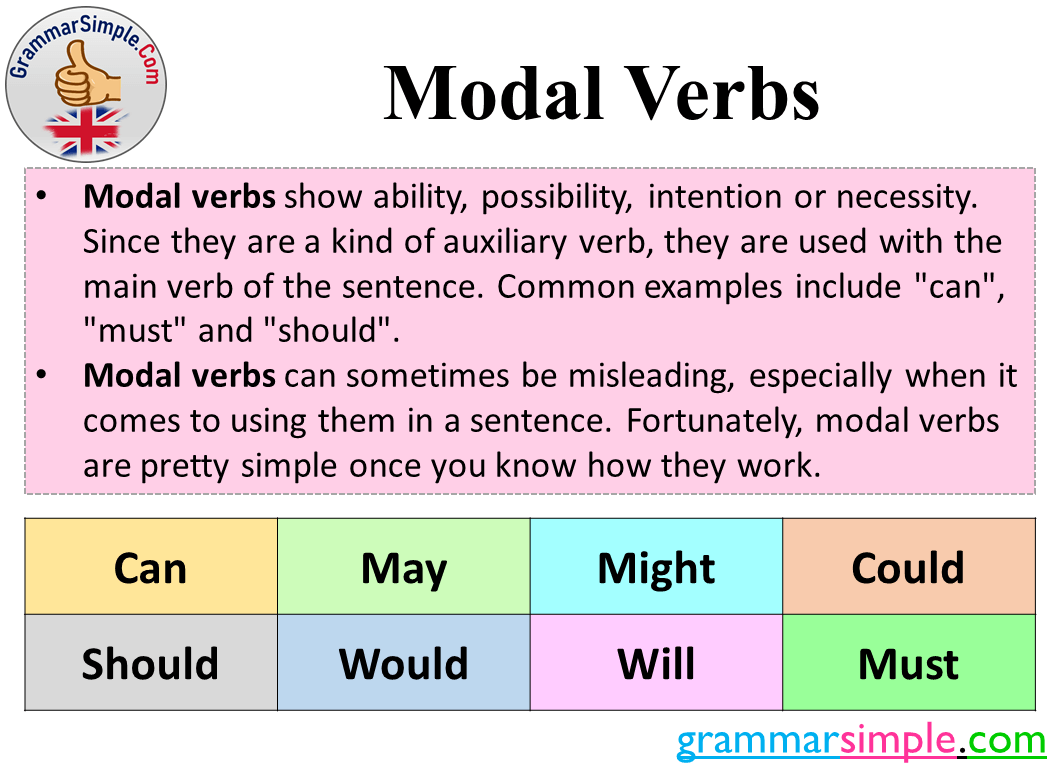What is Modal Verb? Modal Verbs List and Example Sentences


What is Modal Verb? Modal Verbs List and Example Sentences
Table of Contents
Modal Verbs
Modal verbs show ability, possibility, intention or necessity. Since they are a kind of auxiliary verb, they are used with the main verb of the sentence. Common examples include “can“, “must” and “should“.
Modal verbs can sometimes be misleading, especially when it comes to using them in a sentence. Fortunately, modal verbs are pretty simple once you know how they work.
Modal verbs are used to express certain imprecise conditions, such as advice, abilities, or wishes. They are used next to the main verb to partially change its meaning. They cannot be used alone because they are auxiliary verbs. As an exception to this situation, modal verbs should appear alone only if it is clear from context what the main verb is.
Consider the difference between these two examples:
- I exercise every Friday.
- I can exercise every Friday.
The first example is a simple factual statement. The speaker attends a sporting event on Fridays every week.
The second example uses the modal verb can. Notice how the meaning has partially changed. The speaker does not exercise every Friday; He says he can exercise every Friday if needed. This does not imply any certainty.
What are Modal Verbs?
“Modal verbs” are quite common in English, which we have probably seen many times without knowing their names. The ones with the highest frequency of use are:
| Can | May | Might | Could |
| Should | Would | Will | must |
Although the above is used with great frequency, there are more modal verbs. Some modal verbs are obsolete, obsolete or rarely used, while others are more colloquial. Examples of these are modal verbs such as need to, got to or must. Some express very specific conditions that do not occur often, such as dare, for example, “I dare say.” Like the sentence “I was an English student too” formerly, the phrase also acts as a modal verb.
When are Modal Verbs Used?
To explain when to use modal verbs with examples, we can list the following:
Likelihood
Some cases seem likely, but we still don’t know for sure. In these cases, we can use the modal verbs must and should to indicate probability without specifying any certainty.
- He must have arrived in Washington by now.
- His father must be proud of him.
Possibility
Use the modal verbs can, might, or may when something is possible but not certain.
- Judging by the clouds, it could snow tomorrow.
Ability
Modal verbs can indicate whether the subject is capable of doing something, such as performing an action or showing an ability. Likewise, the negative form cannot or can’t indicates that the subject cannot do something.
- He can speak English but does not have a good grasp of grammar rules.
- Alice can swim but not fish.
Asking Permission
If you want permission to do something, you should start your question with can, may, or could. Traditionally, in the more formal and polite usage may is better to get permission; “Can I sleep?” If you ask, “Do I have the ability to sleep?” However, in modern usage, both can be perfectly acceptable options when describing possibility or permission.
- May I leave early today?
- Could I play too?
Request
Similarly, if you ask someone else to do something, start your question with will, would, can, could.
- Can you get that box from the top shelf?
- Can you turn off that loud and annoying music?
Suggestion/advice
Let’s say you want to suggest something, but at the same time you don’t want to command it. If you want to give advice or suggestion to someone around you without giving orders, you can use the modal verb.
- You must try this delicious Russian dish.
- This student should study more.
Command
If you intend to command someone, you should use the modal verbs must, have to or need to.
- When you come home from outside, you should take a shower.
- You have to be at school by 7:00.
Obligation or Necessity
Modal verbs can express an action, such as an obligation, duty, or necessity. Likewise, the negative form expresses that an action is not necessary. Use the same modal verbs as commands: must, have to, or need to.
- We have to obey the traffic rules while driving.
- You don’t have to eat if you don’t want to.
Habit
To indicate an ongoing or habitual action – something the subject does regularly – happens for the past tense and you can use the verb will for the present and the future. If you are talking about a habit that no longer exists, the phrase used is also acceptable.
- When I lived alone, I would fall asleep to the music.
- I will come to every meeting early and leave late.
Recent Posts
Use Rose in a Sentence, How to Use Rose with Example Sentences
Use Rose in a Sentence, How to Use Rose with Example Sentences
Use Yourself in a Sentence, How to Use Yourself with Example Sentences
Use Yourself in a Sentence, How to Use Yourself with Example Sentences
Use Picture in a Sentence, How to Use Picture with Example Sentences
Use Picture in a Sentence, How to Use Picture with Example Sentences
Use Claim in a Sentence, How to Use Claim with Example Sentences
Use Claim in a Sentence, How to Use Claim with Example Sentences
Use Treasure in a Sentence, How to Use Treasure with Example Sentences
Use Treasure in a Sentence, How to Use Treasure with Example Sentences
Use Raise in a Sentence, How to Use Raise with Example Sentences
Use Raise in a Sentence, How to Use Raise with Example Sentences